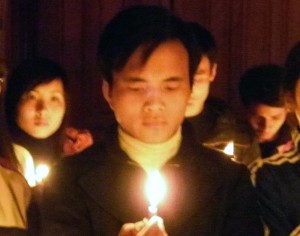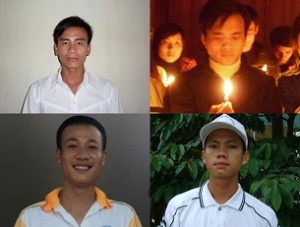Radio Free Asia, December 20, 2016
The poor design and management of Vietnam’s power-generating dams are likely one of the main factors that led to recent deadly floods that inundated the country’s central provinces, experts tell RFA.
Flooding over the past two months has devastated Vietnam’s central provinces, killed dozens of people and caused millions of dollars in economic damage as unusually heavy rain has pelted the country.
While heavy rainfall is rare in Vietnam for this time of year, not all of the devastation can be blamed on a fluke of nature, as experts tell RFA’s Vietnamese Service that poor engineering and greed also contributed to the destruction.
On Dec. 16 state media reported that 13 hydroelectric dams were simultaneously discharging water in the inundated areas of the country and that the Tranh River No. 2 Reservoir had actually increased its discharge volume.
While it is sometimes necessary to discharge large amounts of water in order to prevent a dam from breaking and creating an even bigger disaster, a former irrigation minister said the dams themselves aren’t up to snuff.
“The designers failed to make the reservoirs to the proper standards, and then the managers run them at will,” Tran Nhon, a former minister of irrigation and chairman of Vietnam Irrigation Association told RFA. “When the water in the reservoirs swells near to the normal level, they let water discharge for fear of bursting.”
While Tran criticized the engineering, noted economist Le Dang Doanh told RFA that dams in the central provinces are ill-equipped for flood control and irrigation.
“Unlike the reservoirs in the north that can hold water for agriculture in the dry season and prevent flooding, the reservoirs in the central region fail at those tasks,” he said. “He accused the companies responsible for the dams in the central provinces of being more concerned with generating profits than protecting people downstream.”
‘Now the negative impacts come out’
“The companies succeeded in getting permits for hydroplant construction to do business,” he said. “Besides getting profits from selling electricity, they also get money from trees near the reservoirs.”
At first glance harvesting timber appears to have little to do with flood control, but trees make good sponges and help prevent erosion.
“Each tree can hold back between 30 to 60 liters of water,” Le explained. “But a million trees have been cut.”
Dam builders oversold their benefits and underestimated their costs.
“Hydroelectricity plant developers united in getting the permits to build, and now the negative impacts come out,” he said.
So far Hanoi has been silent over what role, if any, the dams played in the flooding, but hydrology experts haven’t been shy about their views on social media.
Activist Nguyen Van Thanh, who has been pushing the government to compensate the Vietnamese people for their losses, criticized the dam operators and their government backers.
“The hydroplants are in the production business,” he said. “They sell the products and make a profit, and have to comply with community safety standards. If a water discharge does harm to other people, they have to compensate them.”
But since the dam operators are ultimately owned by the state, compensating the flood victims would cut into their own profits, he said.
“By every means the authorities make threats so that everyone is afraid,” Nguyen said. “Then nothing gets done.”
Height Insoles: Hi, I do believe this is an excellent site. I stumbledupon …
http://fishinglovers.net: Appreciate you sharing, great post.Thanks Again. Keep writi…
Achilles Pain causes: Every weekend i used to pay a quick visit this site, as i w…






December 21, 2016
Dam Design and Greed May Factor Into Flood Devastation in Vietnam
by Nhan Quyen • [Human Rights]
Radio Free Asia, December 20, 2016
The poor design and management of Vietnam’s power-generating dams are likely one of the main factors that led to recent deadly floods that inundated the country’s central provinces, experts tell RFA.
Flooding over the past two months has devastated Vietnam’s central provinces, killed dozens of people and caused millions of dollars in economic damage as unusually heavy rain has pelted the country.
While heavy rainfall is rare in Vietnam for this time of year, not all of the devastation can be blamed on a fluke of nature, as experts tell RFA’s Vietnamese Service that poor engineering and greed also contributed to the destruction.
On Dec. 16 state media reported that 13 hydroelectric dams were simultaneously discharging water in the inundated areas of the country and that the Tranh River No. 2 Reservoir had actually increased its discharge volume.
While it is sometimes necessary to discharge large amounts of water in order to prevent a dam from breaking and creating an even bigger disaster, a former irrigation minister said the dams themselves aren’t up to snuff.
“The designers failed to make the reservoirs to the proper standards, and then the managers run them at will,” Tran Nhon, a former minister of irrigation and chairman of Vietnam Irrigation Association told RFA. “When the water in the reservoirs swells near to the normal level, they let water discharge for fear of bursting.”
While Tran criticized the engineering, noted economist Le Dang Doanh told RFA that dams in the central provinces are ill-equipped for flood control and irrigation.
“Unlike the reservoirs in the north that can hold water for agriculture in the dry season and prevent flooding, the reservoirs in the central region fail at those tasks,” he said. “He accused the companies responsible for the dams in the central provinces of being more concerned with generating profits than protecting people downstream.”
‘Now the negative impacts come out’
“The companies succeeded in getting permits for hydroplant construction to do business,” he said. “Besides getting profits from selling electricity, they also get money from trees near the reservoirs.”
At first glance harvesting timber appears to have little to do with flood control, but trees make good sponges and help prevent erosion.
“Each tree can hold back between 30 to 60 liters of water,” Le explained. “But a million trees have been cut.”
Dam builders oversold their benefits and underestimated their costs.
“Hydroelectricity plant developers united in getting the permits to build, and now the negative impacts come out,” he said.
So far Hanoi has been silent over what role, if any, the dams played in the flooding, but hydrology experts haven’t been shy about their views on social media.
Activist Nguyen Van Thanh, who has been pushing the government to compensate the Vietnamese people for their losses, criticized the dam operators and their government backers.
“The hydroplants are in the production business,” he said. “They sell the products and make a profit, and have to comply with community safety standards. If a water discharge does harm to other people, they have to compensate them.”
But since the dam operators are ultimately owned by the state, compensating the flood victims would cut into their own profits, he said.
“By every means the authorities make threats so that everyone is afraid,” Nguyen said. “Then nothing gets done.”